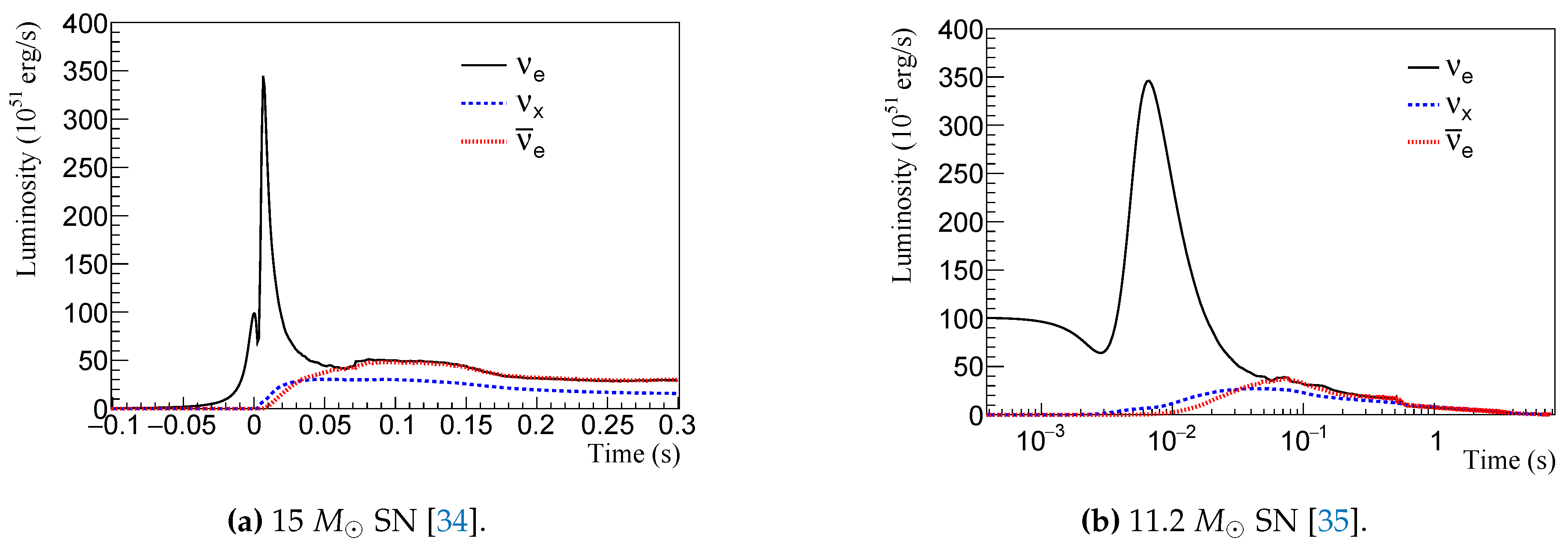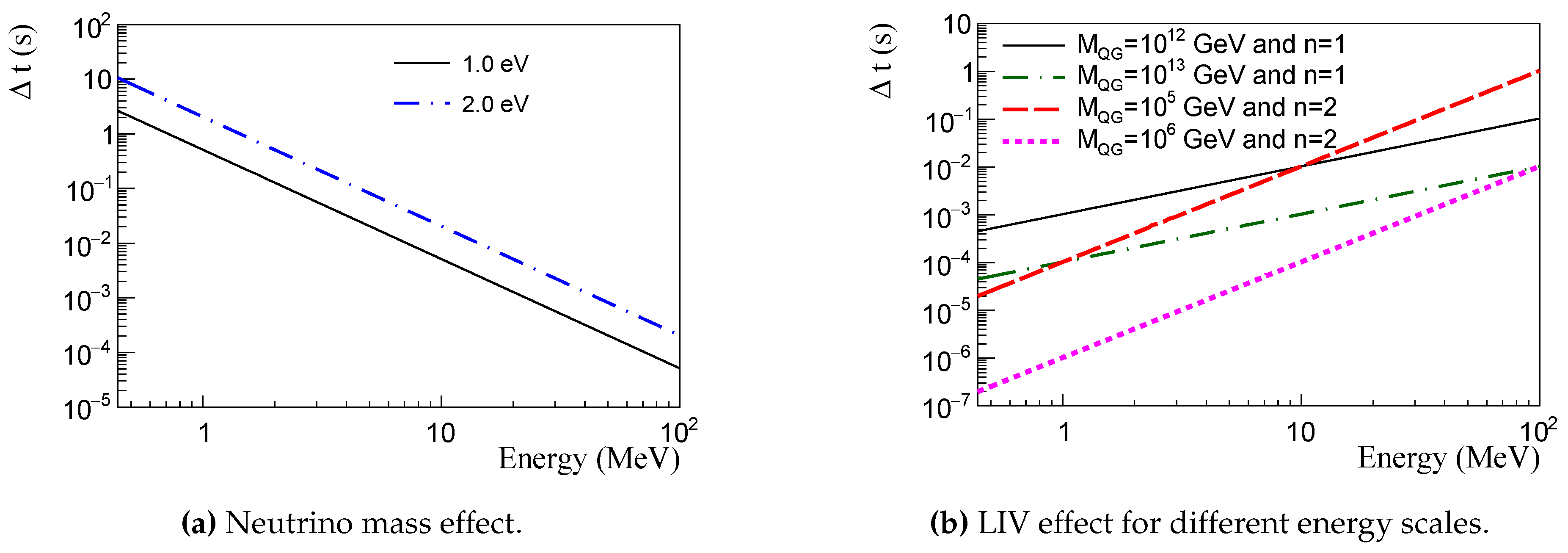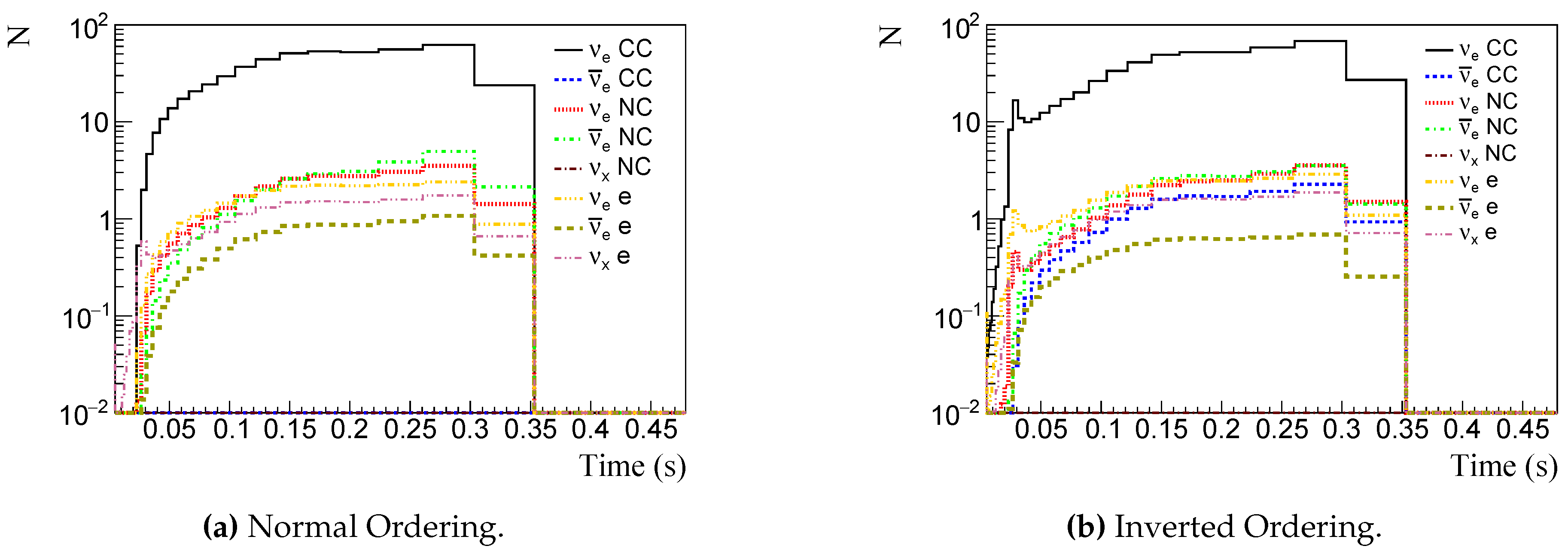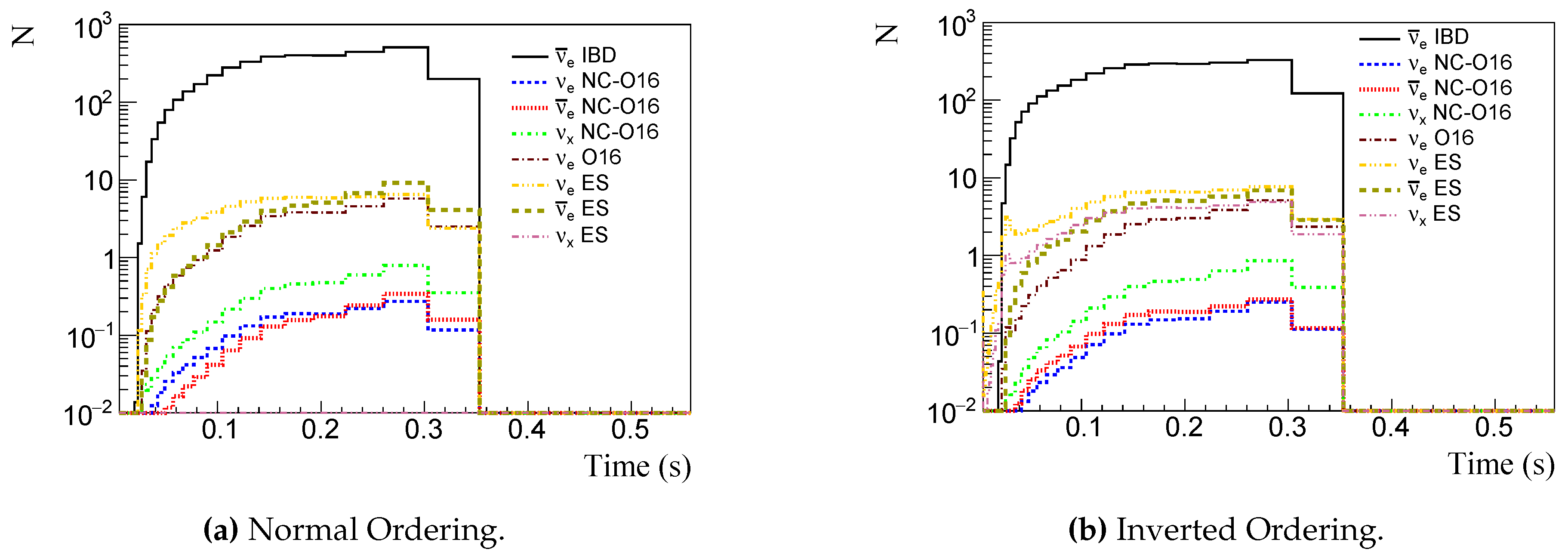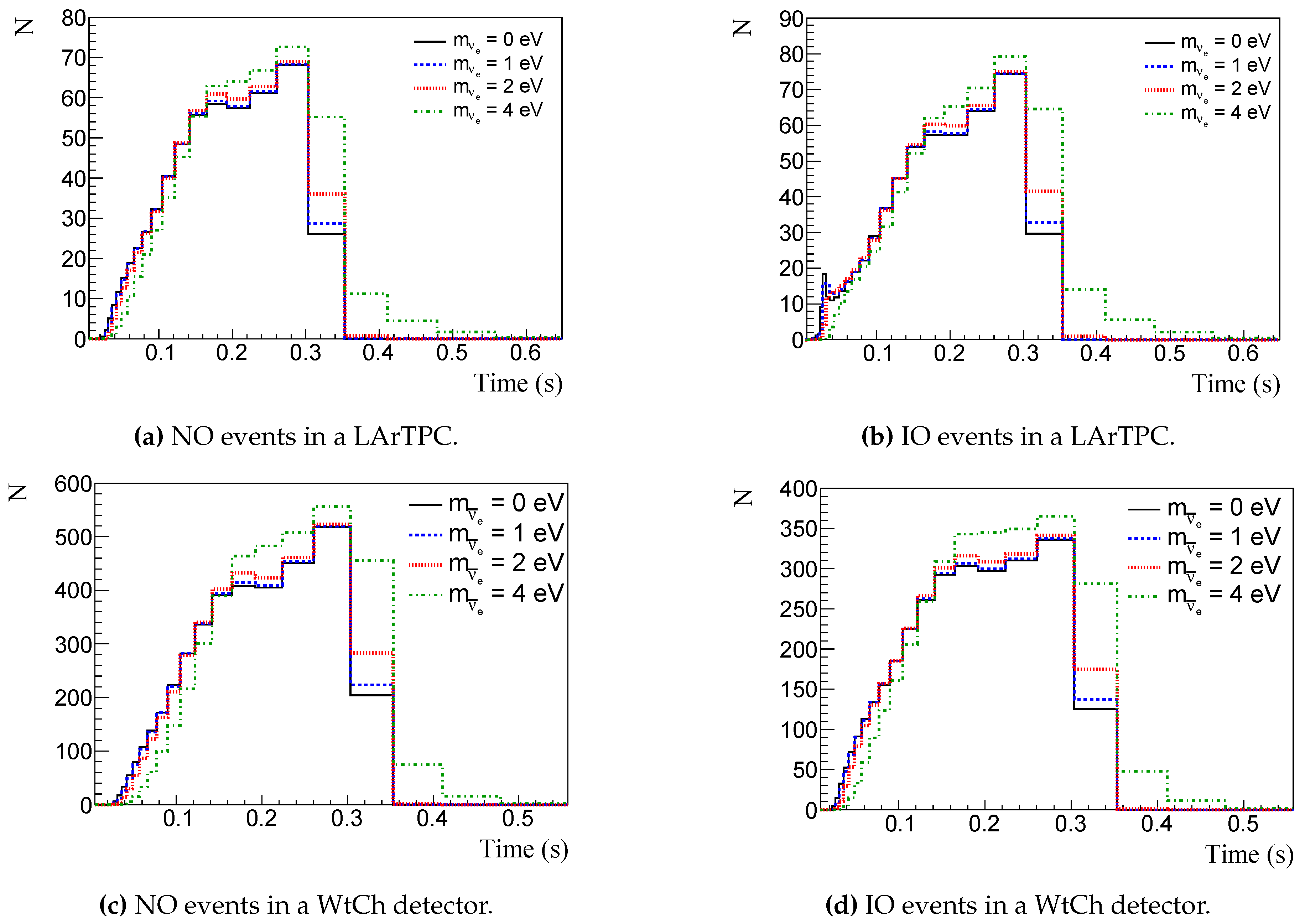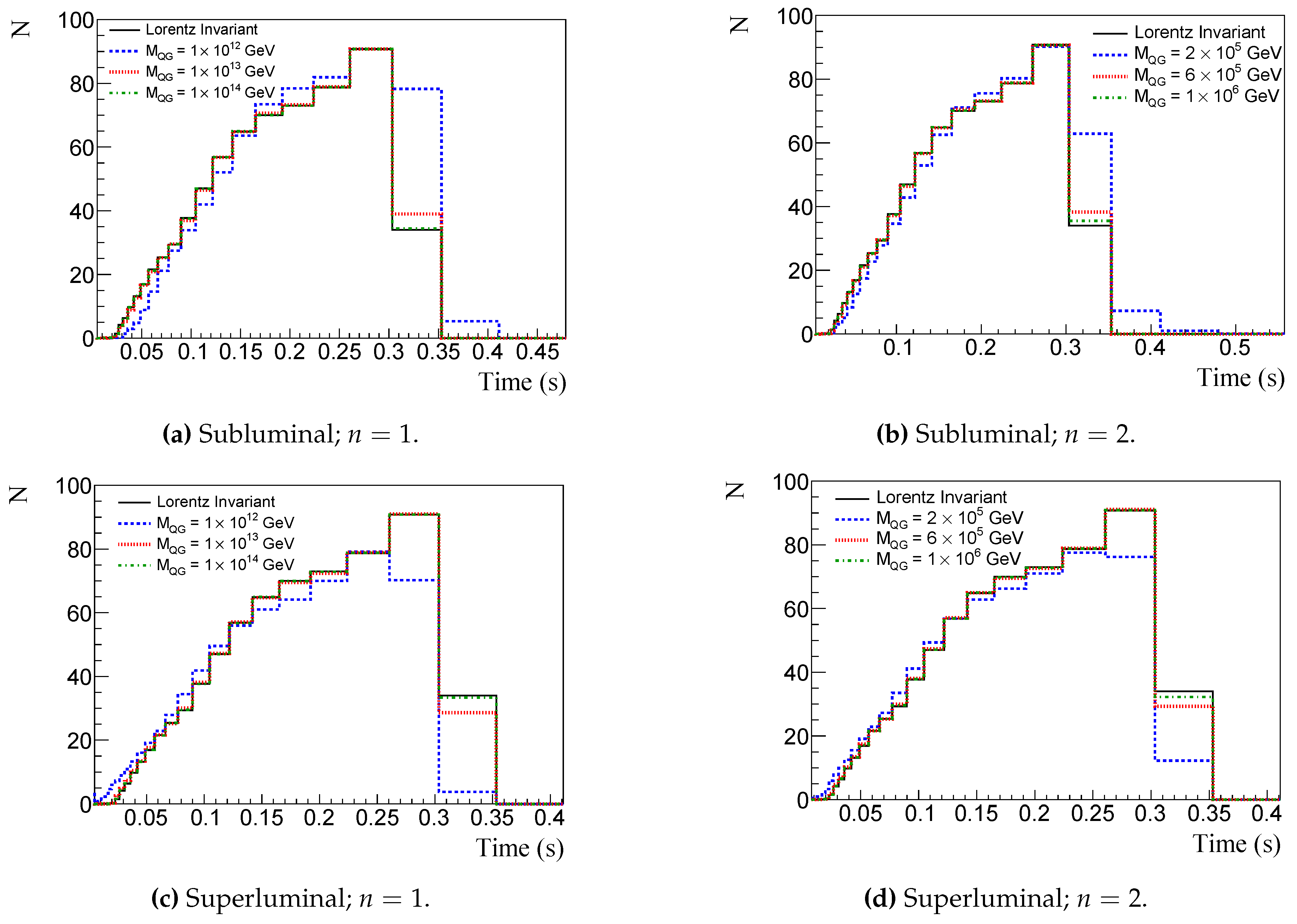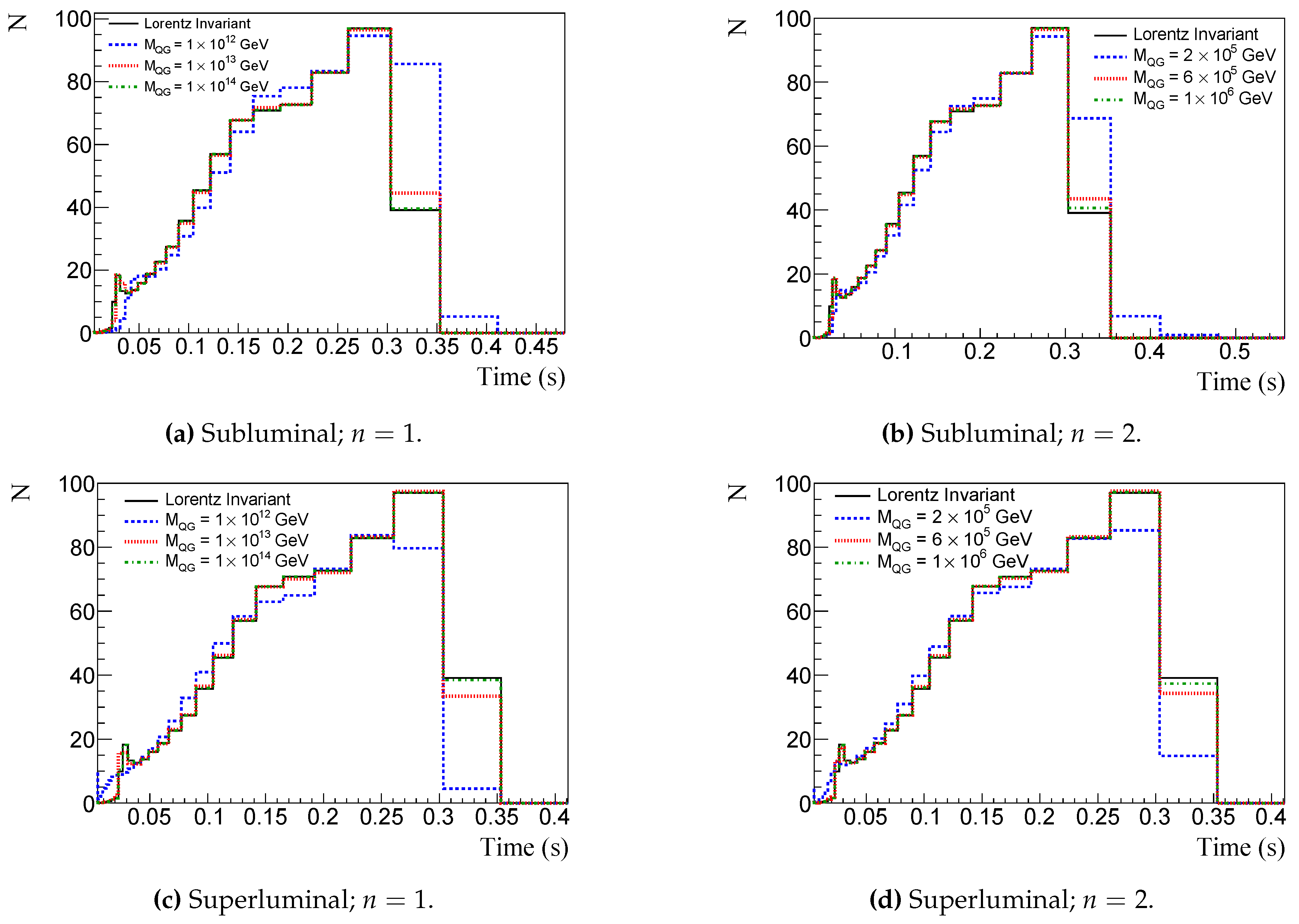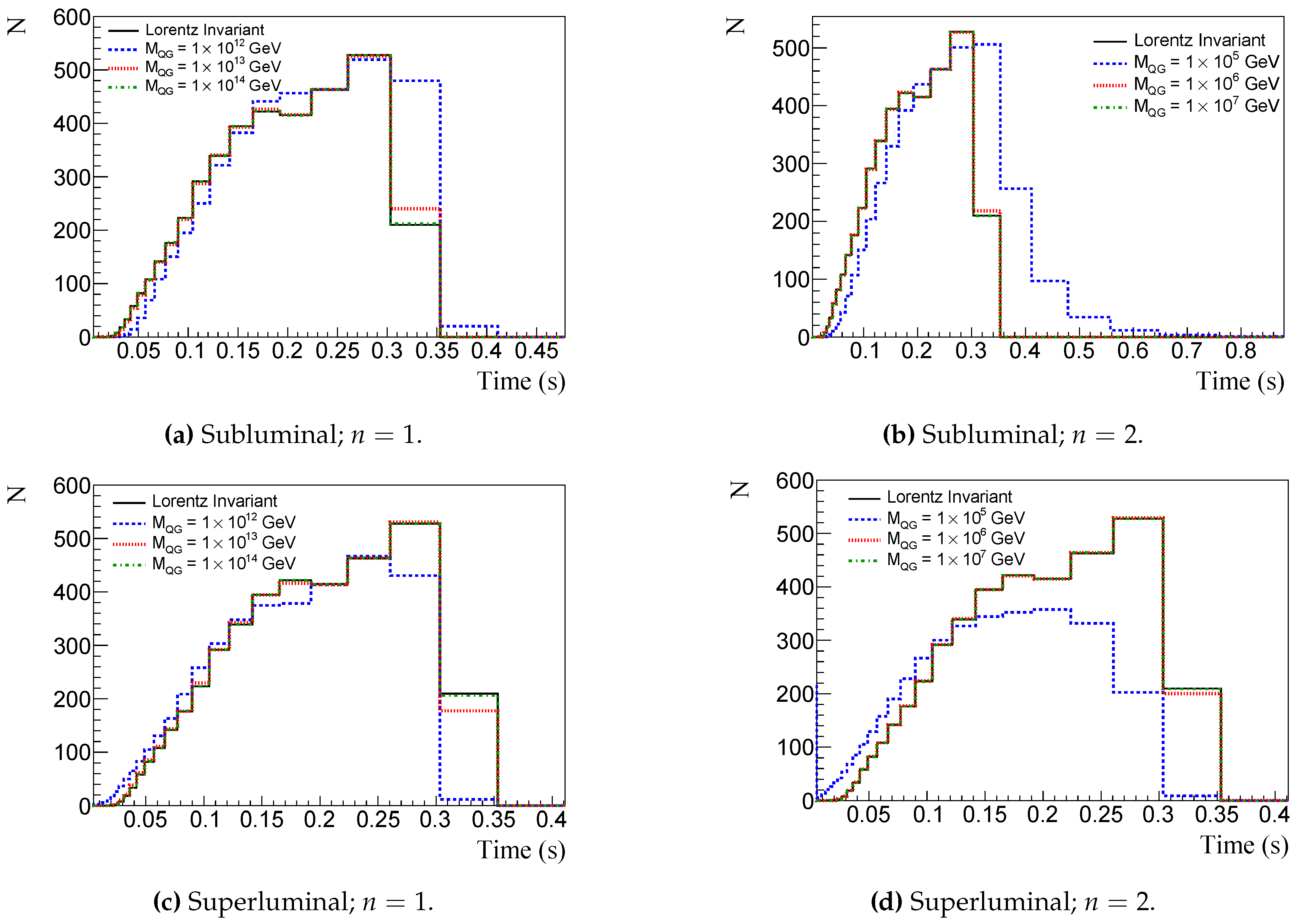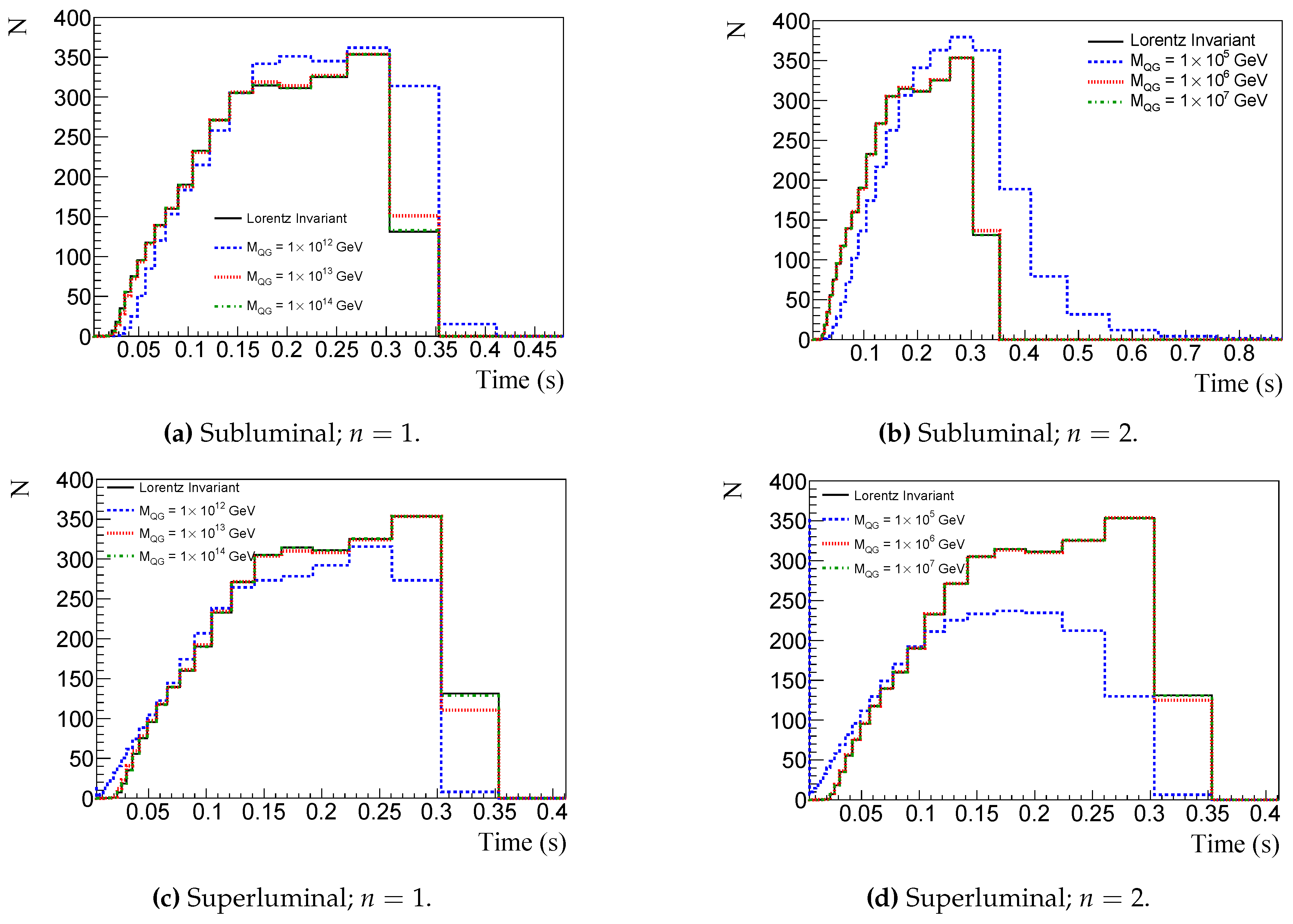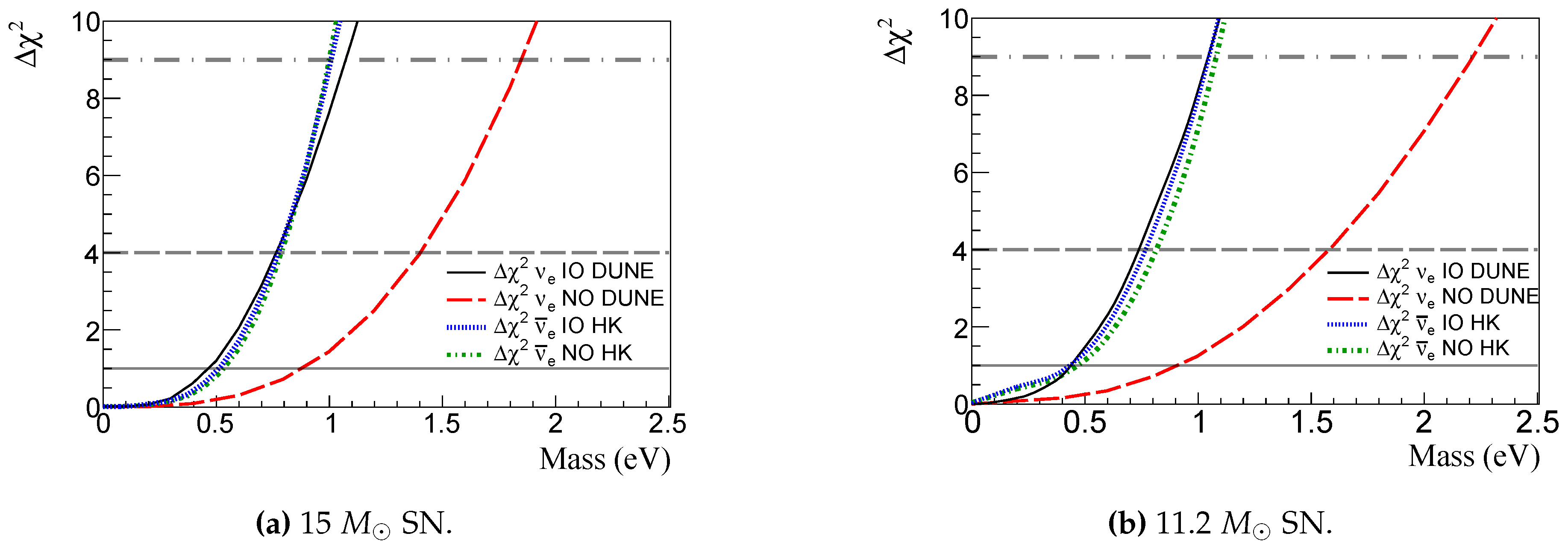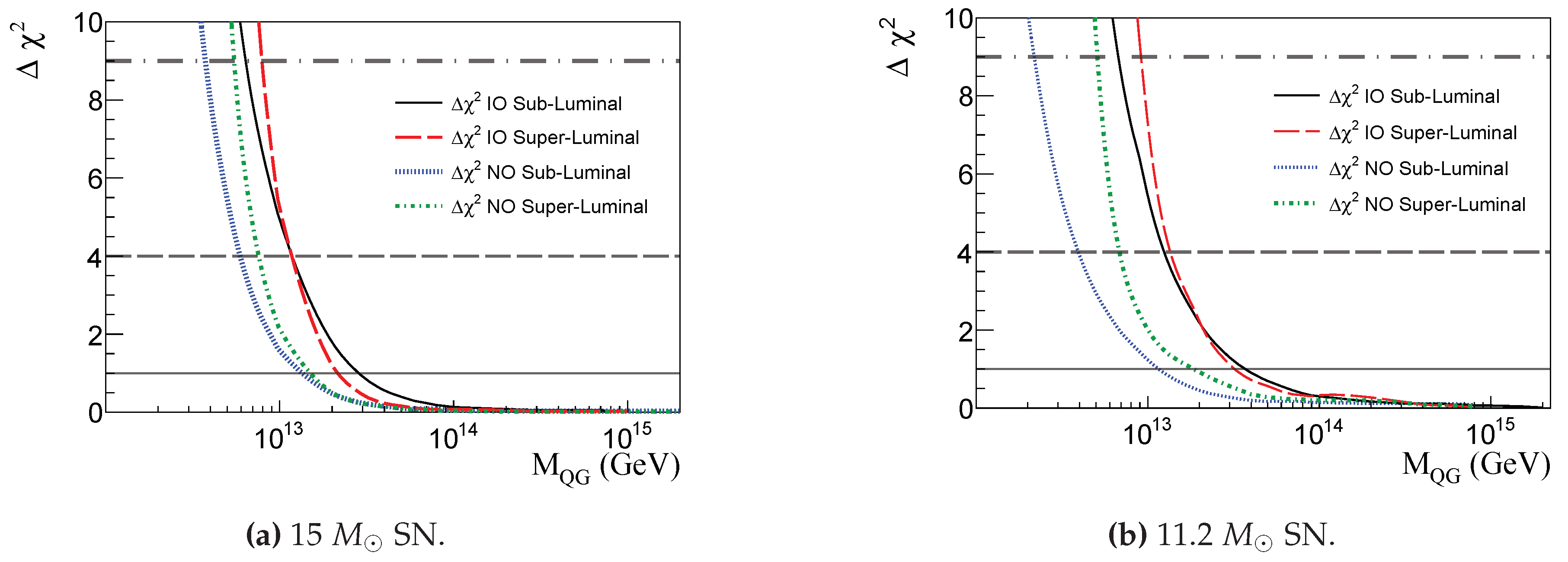1. Introduction
One of the most important and still open questions in neutrino physics is the absolute value of neutrino masses. In addition to this question, we do not have a completely proven model of a mass generation mechanism that could explain the existence of this non-zero mass. Despite the lack of a complete picture of the neutrino mass generation mechanism, in recent years, we have seen a great progress in neutrino physics especially coming from oscillation experiments [
1]. These experiments point to the fact that neutrino mass eigenstates mix during propagation, giving rise to neutrino flavor oscillation. The present oscillation experimental data cannot point out which mass eigenstate is the lightest one, two options being possible: normal ordering (NO),
; or inverted ordering (IO),
. Oscillation experiments usually measure
, the mass squared differences in module, and
, the mixing angles of the mass eigenstates, where
and
. From matter effect in oscillation, we do know that
is positive. Recent values of the oscillation parameters, with 1
uncertainty, can be found in, e.g., Ref. [
1].
One of the possible sources of neutrinos is the collapse of stars. This process emits around 99% of the star internal energy in the form of neutrinos and antineutrinos with average energy of the order of 10 MeV. The detection of the supernova (SN) neutrino burst is crucial in order to understand the stellar explosion mechanism and it can provide an early warning for electromagnetic observation experiments [
2].
During the stellar collapse that leads to the explosion of a SN, neutrino emission occurs in different stages. The first stage is neutronization, in which a fusion reaction between electrons and protons produces neutrons and electron neutrinos (
). This process produces a peak in the
luminosity curve as a function of time that lasts for about 25 ms. During neutronization,
s are trapped behind the shock wave formed by the collapse and are only released when the matter density becomes sufficiently low. The second stage is accretion, in which the matter from the collapsing star is attracted to the newly formed neutron star, producing neutrinos of all flavors. In this stage, all types of neutrinos are emitted. The third stage is the cooling, which occurs after the SN explosion. During the cooling, the neutron star releases all types of neutrinos and decreases its binding energy. For reviews of SN neutrinos and neutrino emission properties, see Ref. [
3]. The impact of neutrino mass ordering - NO or IO - is relevant for the measurement of the neutronization burst [
4].
There are several ways for measuring the neutrino mass and important constraints already exist. Before we discuss our estimate using SN neutrinos, we list a few constraints from different techniques.
From the high energy spectrum range of tritium beta decay, the Katrin experiment found a limit of 0.8 eV at 90% C.L. [
5]. Other nuclei, such as
Re and
Ho may also
decay and provide limits [
6]. From the electron capture decays of
Ho (
),
eV at 95% C.L. [
7] and
eV at 68% C.L. [
8]. In the MANU experiment, with
Re
decay, it was found an upper limit of 26 eV at 95% C.L. [
9]. The MiBeta Collaboration obtained an upper limit of 15 eV at 90% C.L. [
10]. Recently, the Project 8 Collaboration, using the Cyclotron Radiation Emission Spectroscopy (CRES) technique and a cm
scale physical detection volume, obtained
eV from the continuous tritium beta spectrum [
11].
Despite the uncertainties in the nuclear matrix elements from neutrinoless double
decay (
) [
12], experiments that study
from
Xe nuclei, such as the KamLAND-ZEN [
13] and EXO-200 [
14], constrained, respectively,
eV and
eV. In this lepton-number violating process, the decay rate of the nuclei scales with the effective neutrino mass, where the neutrino is a Majorana fermion. The Heidelberg-Moscow collaboration claimed evidence of this phenomenon with
eV,
representing the coherent sum of masses (
) of the mass eigenstates [
15].
Cosmology also imposes limits on neutrino masses. Neutrinos have large free streaming length, which depends on their masses. They smear out fluctuations that are imprinted in the cosmic microwave background and in galaxies. From cosmic microwave background, using the Planck satellite,
eV at 95% C.L. [
16], even though there are several degeneracies related to the cosmological model parameters [
17].
All bounds described above are summarized in
Table 1.
Neutrino mass bounds can be obtained from type II SN bursts, which have short duration and happen at astronomical distances. The idea is that neutrinos travel long distances in a time that depends on their mass as well as on their energy. So there is a delay compared to the time of flight of a supposedly massless particle that impacts the time spectrum of the neutrino events at the Earth [
18,
19].
Using SN1987A inverse
decay data (
) from Kamiokande [
20], IMB [
21] and Baksan [
22], an upper limit of
eV at 95% C.L. [
23] was obtained using a proper likelihood of event-by-event analysis [
24]. Lamb & Loredo, in a similar analysis, constrained the neutrino mass to be less than 5.7 eV [
25]. The future Jiangmen Underground Neutrino Observatory (JUNO) [
26], a 20 kton liquid-scintilator detector using the inverse beta decay channel, may limit the neutrino mass with a SN at 10 kpc distance and NO as
eV at 95% C.L. A sub-eV mass limit, for a future SN, may be reached in several detectors using a time structured signal, as demonstrated in Ref. [
27].
Liquid Argon TPC (LArTCP), such as the far detector of the future Deep Underground Neutrino Experiment (DUNE) [
28,
29], is sensitive to the detection of electron neutrinos (
) from SN [
30]. Depending on the type of neutrino mass ordering, such detector can be important to prove the existence of the neutronization process in explosions of massive stars. A detector with 40 kton of liquid argon can detect thousands of events. Furthermore, the short temporal duration of the neutronization peak may place more restrictive constraints on physical parameters associated with arrival time spectrum changes. It is expected a sensitivity of around 0.90-2.00 eV for the neutrino mass [
30,
31].
Cherenkov light detectors, sensitive to
, can probe the entire neutrino emission period of a SN event, making it possible to establish limits on neutrino mass [
23,
25]. Hyper-Kamiokande (HyperK) - the next generation and improved Super-Kamiokande (SK) - will work with a water Cherenkov detector (WtCh) and is very sensitive to the detection of
via
. For HyperK, it is expected an absolute mass sensitivity from 0.5 to 1.3 eV [
32].
In this work, we revisit the obtention of an effective mass limit and, inspired by [
33], we also include an analysis of Lorentz Invariance Violation (LIV). We explore the time spectrum changes caused, independently, by neutrino mass or LIV along the neutrino propagation from the SN to the Earth. We consider two different masses of progenitor star at a distance of 10 kpc and two types of detectors: a DUNE-like 40 kton LArTPC and a HyperK-like 100 kton WtCh detector. The two mass orderings are considered in order to explore the different sensitivities to neutrino mass and LIV energy scale.
This article is organized as follows: In
Section 2, we show how to evaluate the neutrino fluxes in SN and their respective fluxes at Earth after oscillations. In
Section 3, we discuss the method developed to evaluate the number of events and the calculation of the squared function,
, minimized in order to put bounds on the neutrino mass or LIV.
Section 4 presents some details of the experiments we simulate in our study and their related number of events per channel of detection. In
Section 5, we present our main results for the limits of neutrino mass or LIV and discuss them. Finally, in
Section 6, we present our main conclusions and future perspectives.
2. Neutrino fluxes
Inside the star, each neutrino flavor
(
) has a differential flux, at time
t after the bounce of the SN core, described as [
3],
where
is the neutrino flavor luminosity,
d is the SN distance to the Earth detector,
is the neutrino energy spectra and
is the mean neutrino energy.
,
and
depend on the SN model.
We consider two models with different progenitor masses: One with 15 solar masses (15
) [
34] and one with 11.2
[
35].
Figure 1a and
Figure 1b show the
(black solid line),
(red dotted line), and
(blue dashed line) luminosity time evolution the two models.
The neutrino energy spectra can be parameterized as [
36],
where
is the so-called pinching parameter that is model dependent and accounts for the variations in the quasi-thermal spectrum.
is the time dependent normalization factor, so that
.
Inside the star environment, neutrinos interact with electrons, protons, and neutrons, suffering flavor conversion in the resonances (low and high) according to the MSW effect [
37]. After crossing the stellar matter, neutrinos travel incoherently through vacuum until when they are detected at Earth. The expressions for the oscillated differential fluxes, which are shown below, are obtained from Ref. [
38].
The differential
flux at Earth for NO is,
while for the flavors
,
,
, and
, represented by
, can be written as,
where
is the mixing angle between
and
mass eigenstates.
The differential
flux is,
The mixing angle
is considered small compared to
and the expressions above are evaluated accordingly. The
value is:
for NO and
for IO [
1].
Now, for IO, we can write the following differential fluxes for
,
, and
, respectively:
and
We do not consider nonlinear collective effects in this work. They are not relevant particularly in the neutronization burst [
3] and would bring unnecessary complication to the oscillation treatment. In Ref. [
39], the authors considered Earth matter effects on neutrino oscillation and their possible effects on the neutrino masses, however, such effects do not considerably affect their results - see their Table I. For the current status of the neutrino flavor conversion in high density environments and its relevance in astrophysical systems as SN, see Ref. [
40].
5. Results and Discussion
In this section, we show the limits on the neutrino masses and LIV scale,
, subluminal and superluminal cases, for NO and IO and both detector types described in
Section 4. The SN distance is fixed at 10 kpc and we consider two distinct models with progenitor masses: 15 M
and 11.2 M
.
In the analysis of the neutrino mass limit, we assume all interaction channels for the DUNE-like detector and all interaction channels for the HyperK-like detector. For , we sum all neutrino flavor events from all interaction channels, since LIV may affect equally the neutrino eigenstates during their propagation.
We discuss the results for the 15
SN model [
34] first.
In
Figure 3a and
Figure 3b one sees the number of events,
N, in a 40 kton LArTPC, as a function of bins of time. Each curve shows a different detection channel. On the left (right) side of
Figure 3,
Figure 3a (
Figure 3b) considers NO (IO). The
interactions are represented by: (i) black solid curves - CC interaction with Argon; (ii) red dotted - NC interaction with Ar; (iii) yellow dash-dotted - ES on
. The
interactions are represented by: (i) blue dashed curves - CC interaction with Argon; (ii) green dash-dotted - NC interaction with Ar; (iii) brown dashed - ES on
. Other flavors interact with Argon by NC (violet dashed-dot curves) and ES (magenta dash-double dotted curves).
We show equivalent curves in
Figure 4a and
Figure 4b for a 100 kton WtCh detector. The main channel in this case is the inverse beta decay (IBD) used to probe
. Colored lines show
NC interaction with
O (red dotted) and ES on
(brown dashed);
interactions with
O via CC (violet dash-dotted) and NC (blue dashed), and
ES on
(yellow dash-two dotted). Other flavors interact via ES on
(magenta dash-two dotted) and NC interaction with
O (green dash-dotted).
Figure 5 shows the time distribution of the
(
Figure 5a and
Figure 5b) and
(
Figure 5c and
Figure 5d) event number for a 40 kton LArTPC detector and 100 kton WtCh detector, respectively. Left (Right) plots consider NO (IO). The solid black line refers to a massless neutrino. To illustrate the time delay caused by different mass values, blue dashed refers to 1 eV neutrino mass, red dotted to 2 eV, and green dash-dotted to 4 eV.
The mass values were chosen in order to illustrate the effect of the mass in the signal time delay as described by Eq. (
17).
Figure 5a and
Figure 5b show the relevance of mass ordering to probe the neutronization burst, which is suppressed in NO. On the other hand, for
,
Figure 5c and
Figure 5d, the neutronization burst is not present. We notice a larger number of events in the HyperK-like detector since it is larger in size and the inverse
decay cross section, which is the main channel of interaction, is larger than the CC
-Ar cross section.
Figure 6 and
Figure 8 (
Figure 7 and
Figure 9) show the time spectrum considering NO (IO) for a 40 kton LArTPC detector and a 100 kton WtCh detector, respectively. In all figures top (bottom) panels show the time spectrum change due to subluminal (superluminal) LIV, left (right) panels consider energy dependence
(
), black solid lines refer to conserved Lorentz invariance, blue dashed line to
GeV (
GeV), red dotted line to
GeV (
GeV), and green dash-dotted to
GeV (
GeV). We notice that the less the value of
the greater the effect of LIV in
- see Eq. (
18). As we mentioned before, LIV models predict the possibility of superluminal propagation, causing an advance in the detection time. This can be seen in the bottom of
Figure 6,
Figure 7,
Figure 8 and
Figure 9. A time delay like the effect of neutrino mass, but with different energy dependence, can be seen by the subluminal LIV effect in the top of
Figure 6,
Figure 7,
Figure 8 and
Figure 9.
Using Eq. (
19), we obtain the
in terms of neutrino mass and
.
The mass limits are shown in
Figure 10a for the LArTPC and WtCh detectors. The mass bounds for
(
) in a 40 kton LArTPC (100 kton WtCh) are represented by solid black (dotted blue) line and dashed red (dash-dotted green) line, respectively, for IO and NO.
As expected, we see better limits for IO and in the DUNE-like detector because of the peak of neutronization. In the NO, the suppression of the neutronization peak worsen the sensitivity. For the HyperK-like detector, the limits on , for both mass orderings, are very similar, as the time spectrum does not change significantly.
Our results for
and
are summarized in
Table 2. The numbers inside parentheses and without parentheses represent the mass limits for the LArTPC and WtCh detector, respectively.
Some comments on the mass are important. Supposedly, the mass eigenstates of neutrinos travel freely through space and arrive incoherently at the detector, i.e.,
,
, and
arrive separately and these mass eigenstates have in fact the mass information. Consider for instance NO, where
is the lightest mass eigenstate and reaches the detector first. If there is an interaction, the wave function collapses,
2 thus selecting the flavor state of the neutrino, such as e.g.
, with a detection probability given by the PMNS matrix element
.
3 If
does not interact, the eigenstate
, which arrives at the detector with its respective delay associated with its mass
, may interact. The time interval between
and
can be estimated as [
46],
Using
eV
,
kpc, and
MeV in Eq. (
20), we obtain
s. For
eV
,
s. One needs a detector with time resolution better than
to allow the determination of the mass bound of each mass eigenstate. In our analysis, according to the expected experimental time resolution, we group the events in certain time intervals longer than the
. So we put limits for an effective mass of the detected flavor.
The limits on LIV are shown in
Figure 11a with the
in terms of
for the 40 kton LArTPC. We show the superluminal and subluminal cases, for NO and IO, and
in Eq. (
18). Solid black curve represents the subluminal and IO case, red dashed line represents the superluminal and IO case, dotted blue curve is for the subluminal and NO, and green dash-dotted curve is for the superluminal and NO.
The
has a similar behavior compared to
Figure 11a for
and for the WtCh detector for both
n. So we do not show those curves.
The inferior limits on the
for the subluminal and superluminal LIV effects are summarized in
Table 3 and
Table 4 for
and
, respectively. Numbers without (inside) parentheses are for WtCh (LArTPC) detectors.
We can use the same methodology for other SN models and we choose one model with 11.2
[
35]. This model includes a longer period of neutrino emission, of about 10 seconds, which includes the cooling time in the SN explosion. The main purpose here is to verify the impact of the later neutrino emission times on the bounds of the mass and LIV scale. The time spectrum and
are very similar to the ones presented in the 15
SN case. In
Figure 10b (
Figure 11b), we present, for the 11.2
SN, the
in terms of neutrino mass (LIV energy scale). Like for the neutrino mass, the LIV
for
and for the WtCh detector for both
n have similar behaviors compared to the one in
Figure 11b. So we do not show the
plots for those cases, but only tables with the results.
Our results using the 11.2
SN model, for the
and
mass limits are shown in
Table 5. The numbers inside and without parentheses show limits for LArTPC and WtCh, respectively.
Table 5.
Limits on neutrino masses for a 100 kton WtCh (40 kton LArTPC) detector, for NO and IO, and 11.2 SN at 10 kpc.
Table 5.
Limits on neutrino masses for a 100 kton WtCh (40 kton LArTPC) detector, for NO and IO, and 11.2 SN at 10 kpc.
| |
|
mass(eV) |
| Mass Ordering |
flavor |
|
|
|
| NO |
|
0.45 (1.71) |
0.82 (3.13) |
1.08 (4.64) |
| IO |
|
0.43 (1.66) |
0.77 (3.27) |
1.05 (5.05) |
| NO |
|
1.31 (0.92) |
2.43 (1.58) |
3.71 (2.22) |
| IO |
|
0.65 (0.44) |
1.23 (0.74) |
2.43 (1.04) |
Following the same steps previously mentioned, the inferior limits on the
, considering the subluminal and superluminal LIV effects, using the 11.2
SN model, are summarized in
Table 6 and
Table 7 for
and
, respectively.
Table 6.
Inferior limits on LIV parameter
,
in Eq. (
18), for WtCh (LArTPC) detector, considering NO and IO, and the cases of subluminal and superluminal effects for 11.2
SN, 10 kpc from Earth.
Table 6.
Inferior limits on LIV parameter
,
in Eq. (
18), for WtCh (LArTPC) detector, considering NO and IO, and the cases of subluminal and superluminal effects for 11.2
SN, 10 kpc from Earth.
| |
|
(GeV) |
| |
Mass Ordering |
|
|
|
| subluminal |
NO |
4.1 (1.3) |
1.4 (0.4) |
0.6 (0.2) |
| subluminal |
IO |
8.7 (3.8) |
2.0 (1.4) |
1.2 (0.7) |
| superluminal |
NO |
11.0 (1.9) |
1.7 (0.7) |
0.9 (0.5) |
| superluminal |
IO |
5.1 (3.2) |
1.8 (1.7) |
0.9 (0.9) |
The above results show that for obtaining the neutrino mass limit there is no significant impact when we compare both SN progenitor star masses, with different neutrino emission time periods.
4 For
, the best limit comes from the DUNE-like detector and IO, due to the neutronization burst. In fact, different progenitor masses do not modify significantly the neutronization phase [
45]. This, somehow, demonstrates the relevance to study well the neutronization phase for determining neutrino properties, such as its mass. For the
, the best limit comes from the HyperK-like detector and either mass orderings do not present significant differences for their limits.
For the LIV scale sensitivity, we obtain, with both detectors and both mass orderings, either for
or
, very similar limits. This is related to the fact that LIV affects equally the different neutrino mass eigenstates and the analysis is conducted assuming all detection channels. There is no significant difference in the results for the SN models that we consider. The inferior limits obtained by Chakraborty et al. [
33], for a Mton water Cherenkov detector and using the neutronization burst signal are
GeV (
GeV) for
(
). They are very similar to ours - see
Table 3,
Table 4,
Table 5,
Table 6 and
Table 7 - however, they did not conduct a statistical analysis.
Before the conclusions, we would like to point out some important details to be explored in future analyses: First, the necessity of extending our analysis for other simulations of core-collapse SN, so we can explore the effective impacts of astrophysical parameters of the explosion and their relation to the bounds on neutrino masses and LIV. In addition, other and more massive progenitor stars can produce more events from accretion and cooling [
49]. So, a deeper relation among astrophysical and neutrino parameters can be explored. Second, even though in Ref. [
39] they pointed out that several uncertainties do not seem to impact significantly their parameter limits, it seems reasonable to explore deeply the uncertainties when more details are learned from the detectors developed for experiments like DUNE and HyperK.
6. Conclusions
Summarizing our results, we conduct an analysis comparing the time spectrum of supernova neutrino events taking as a baseline the expected event rate for massless neutrinos and invariance under Lorentz transformation. We compute the event rate for two kinds of detectors and two supernova progenitor star masses considering their location at 10 kpc from the detectors. We also analyze the two neutrino mass ordering possibilities.
Comparing the two supernova models, we did not see big influence in the results coming from different masses or considering later neutrino emission times, with events from the cooling phase of the supernova.
The two kinds of detectors, one a 40 kton liquid argon TPC like DUNE and the other a 100 kton water Cherenkov light detector like Hyper-Kamiokande, are sensitive to different neutrino interaction channels. The former is especially sensitive to electron neutrinos, which are produced in great amounts during the neutronization phase of the supernova, while the later is sensitive to electron antineutrinos through inverse beta decay.
We observe a balance between the event rate during the neutronization phase, for which a DUNE-like detector is more sensitive if the inverted mass ordering happens to be the case, and the detector mass, which is more than two times bigger for a Hyper-Kamiokande-like detector. We verify this fact obtaining the best limits on the neutrino effective masses of approximately 1 eV at 3. The best antineutrino mass limit comes from a Hyper-Kamiokande-like detector and is essentially the same independent of the mass ordering, while the best neutrino mass limit comes from a DUNE-like detector for inverted mass ordering.
We also put limits on Lorentz Invariance Violation considering the energy scale at which Lorentz invariance could be broken. We sum the event rate over all neutrino flavors given that the same violating effect would influence their propagation. It is possible to distinguish between a superluminal and a subluminal violation effect, even though the constraints on the energy scale are similar. For a linear energy dependence, the sensitivity is higher and we find an energy scale limit of GeV. For a quadratic energy dependence, we find a limit of GeV. This limits are compatible with results elsewhere, but here we conduct a more accurate statistical analysis.
Figure 1.
Luminosity time evolution for the two SN progenitor star models analyzed in this work. Black solid line - , red dotted line - , and blue dashed line - .
Figure 1.
Luminosity time evolution for the two SN progenitor star models analyzed in this work. Black solid line - , red dotted line - , and blue dashed line - .
Figure 2.
Delay, , in seconds, considering a source at distance kpc, for different neutrino masses (left plot) and different LIV energy scale (right plot) as a function of neutrino energy. Neutrino mass values presented in the left plot. LIV energy scale and energy dependence, n, presentend in the right plot. See also text for details.
Figure 2.
Delay, , in seconds, considering a source at distance kpc, for different neutrino masses (left plot) and different LIV energy scale (right plot) as a function of neutrino energy. Neutrino mass values presented in the left plot. LIV energy scale and energy dependence, n, presentend in the right plot. See also text for details.
Figure 3.
Number of events per time bin in a 40 kton LArTPC. The interactions are representend by (i) Black solid - CC interaction with Argon; (ii) red dotted - NC interaction with Ar; (iii) yellow dash-dotted - ES on . The interactions are: (i) blue dashed curves - CC interaction with Argon; (ii) green dash-dotted - NC interaction with Ar; (iii) brown dashed - ES on . Other flavors interact with Argon by NC (violet dashed-dot curves) and ES (magenta dash-double dotted curves).
Figure 3.
Number of events per time bin in a 40 kton LArTPC. The interactions are representend by (i) Black solid - CC interaction with Argon; (ii) red dotted - NC interaction with Ar; (iii) yellow dash-dotted - ES on . The interactions are: (i) blue dashed curves - CC interaction with Argon; (ii) green dash-dotted - NC interaction with Ar; (iii) brown dashed - ES on . Other flavors interact with Argon by NC (violet dashed-dot curves) and ES (magenta dash-double dotted curves).
Figure 4.
Number of events per bins of time for a 100 kton WtCh detector. Several detection channels can be distinguished: (i) for - IBD (black solid lines), NC interaction with O (red dotted), and ES on (brown dashed); (ii) - CC (violet dash-dotted) and NC (blue dashed) interaction with O, and ES on (yellow dash-two dotted); (iii) - ES on (magenta dash-two dotted) and NC interaction with O (green dash-dotted).
Figure 4.
Number of events per bins of time for a 100 kton WtCh detector. Several detection channels can be distinguished: (i) for - IBD (black solid lines), NC interaction with O (red dotted), and ES on (brown dashed); (ii) - CC (violet dash-dotted) and NC (blue dashed) interaction with O, and ES on (yellow dash-two dotted); (iii) - ES on (magenta dash-two dotted) and NC interaction with O (green dash-dotted).
Figure 5.
The top (bottom) panels show the number of () events per time bin in a 40 kton LArTPC (100 kton WtCh detector). Left (right) panels consider NO (IO). Black solid line refers to a massless neutrino events, blue dashed to 1 eV neutrino mass, red dotted to 2 eV, and green dash-dotted to 4 eV.
Figure 5.
The top (bottom) panels show the number of () events per time bin in a 40 kton LArTPC (100 kton WtCh detector). Left (right) panels consider NO (IO). Black solid line refers to a massless neutrino events, blue dashed to 1 eV neutrino mass, red dotted to 2 eV, and green dash-dotted to 4 eV.
Figure 6.
Event number per time bin in a 40 kton LArTPC, considering NO, different LIV energy dependence, n, and different energy scale, . Top (bottom) panels show subluminal (superluminal) effect. Left (Right) panels show (). Blue dashed lines represent event numbers for GeV ( GeV), red dotted for GeV ( GeV), and green dash-dotted for GeV ( GeV). Black solid line refers to conserved Lorentz invariance.
Figure 6.
Event number per time bin in a 40 kton LArTPC, considering NO, different LIV energy dependence, n, and different energy scale, . Top (bottom) panels show subluminal (superluminal) effect. Left (Right) panels show (). Blue dashed lines represent event numbers for GeV ( GeV), red dotted for GeV ( GeV), and green dash-dotted for GeV ( GeV). Black solid line refers to conserved Lorentz invariance.
Figure 7.
The same as in
Figure 6, but for IO.
Figure 7.
The same as in
Figure 6, but for IO.
Figure 8.
Event number per time bin in a 100 kton WtCh detector, considering NO, different LIV energy dependence, n, and different energy scale, . Top (bottom) panels show subluminal (superluminal) effect. Left (Right) panels show (). Blue dashed lines represent event numbers for GeV ( GeV), red dotted for GeV ( GeV), and green dash-dotted for GeV ( GeV). Black solid line refers to conserved Lorentz invariance.
Figure 8.
Event number per time bin in a 100 kton WtCh detector, considering NO, different LIV energy dependence, n, and different energy scale, . Top (bottom) panels show subluminal (superluminal) effect. Left (Right) panels show (). Blue dashed lines represent event numbers for GeV ( GeV), red dotted for GeV ( GeV), and green dash-dotted for GeV ( GeV). Black solid line refers to conserved Lorentz invariance.
Figure 9.
The same as in
Figure 8, but for IO.
Figure 9.
The same as in
Figure 8, but for IO.
Figure 10.
depending on
mass considering
(
) event number in a 40 kton LArTPC (100 kton WtCh). Solid black (dotted blue) line and dashed red (dash-dotted green) line, respectively, for IO and NO. SN at 10 kpc. See
Table 2 (
Table 5) for 15
(11.2
) SN.
Figure 10.
depending on
mass considering
(
) event number in a 40 kton LArTPC (100 kton WtCh). Solid black (dotted blue) line and dashed red (dash-dotted green) line, respectively, for IO and NO. SN at 10 kpc. See
Table 2 (
Table 5) for 15
(11.2
) SN.
Figure 11.
in terms of
for the superluminal and subluminal cases and NO and IO for
, considering the 40 kton LArTPC. Black solid curve represents the subluminal and IO case, red dashed represents the superluminal and IO case, blue dotted curve is for the subluminal and NO, and green dash-dotted curve is for the superluminal and NO. SN at 10 kpc. See
Table 3 (
Table 6) for 15
(11.2
) SN.
Figure 11.
in terms of
for the superluminal and subluminal cases and NO and IO for
, considering the 40 kton LArTPC. Black solid curve represents the subluminal and IO case, red dashed represents the superluminal and IO case, blue dotted curve is for the subluminal and NO, and green dash-dotted curve is for the superluminal and NO. SN at 10 kpc. See
Table 3 (
Table 6) for 15
(11.2
) SN.
Table 1.
Neutrino mass limits for different experiments and different experimental methods. Except where it is written otherwise, the confidence intervals are given at 90% C.L.
Table 1.
Neutrino mass limits for different experiments and different experimental methods. Except where it is written otherwise, the confidence intervals are given at 90% C.L.
| Experiment |
Method |
Mass Limit |
| Katrin [5] |
Tritium beta decay |
0.8 eV |
| Springer et al. [7]1
|
capture decays of 163Ho |
225 eV at 95% C.L |
| MANU [9] |
187Re decay |
26 eV at 95% C.L. |
| MiBeta [10] |
187Re decay |
15 eV |
| Project 8 [11] |
CRES |
152 eV |
| KamLAND-ZEN [13] |
|
0.061 - 0.165 eV |
| EXO-200 [14] |
|
0.093 - 0.286 eV |
| Planck [16] |
Cosmic microwave |
0.09 eV at 95% C.L. |
Table 2.
Limits on neutrino masses for a 100 kton WtCh (40 kton LArTPC) detector, for NO and IO, and 15 SN at 10 kpc.
Table 2.
Limits on neutrino masses for a 100 kton WtCh (40 kton LArTPC) detector, for NO and IO, and 15 SN at 10 kpc.
| |
|
mass(eV) |
| Mass Ordering |
flavor |
|
|
|
| NO |
|
0.52 (1.23) |
0.79 (1.93) |
1.00 (2.83) |
| IO |
|
0.49 (1.29) |
0.77 (2.11) |
1.01 (3.08) |
| NO |
|
1.71 (0.88) |
1.90 (1.40) |
2.64 (1.85) |
| IO |
|
0.68 (0.47) |
1.25 (0.77) |
2.01 (1.07) |
Table 3.
Inferior limits on LIV scale
,
in Eq. (
18), for a 100 kton WtCh (40 kton LArTPC) detector, NO and IO, and the cases of subluminal and superluminal effects. A SN with 15
and 10 kpc from Earth is considered.
Table 3.
Inferior limits on LIV scale
,
in Eq. (
18), for a 100 kton WtCh (40 kton LArTPC) detector, NO and IO, and the cases of subluminal and superluminal effects. A SN with 15
and 10 kpc from Earth is considered.
| |
|
(GeV) |
| |
Mass Ordering |
|
|
|
| subluminal |
NO |
2.9 (1.5) |
1.7 (0.6) |
0.9 (0.4) |
| subluminal |
IO |
3.1 (2.9) |
1.7 (1.3) |
0.9 (0.7) |
| superluminal |
NO |
3.1 (1.7) |
1.8 (0.8) |
1.1 (0.6) |
| superluminal |
IO |
3.2 (2.3) |
1.8 (1.3) |
1.2 (0.8) |
Table 4.
Inferior limits on LIV scale
,
in Eq. (
18), for a 100 kton WtCh (40 kton LArTPC) detector, NO and IO, and the cases of subluminal and superluminal effects. A SN with 15
and 10 kpc from Earth is considered.
Table 4.
Inferior limits on LIV scale
,
in Eq. (
18), for a 100 kton WtCh (40 kton LArTPC) detector, NO and IO, and the cases of subluminal and superluminal effects. A SN with 15
and 10 kpc from Earth is considered.
| |
|
(GeV) |
| |
Mass Ordering |
|
|
|
| subluminal |
NO |
8.5 (5.9) |
5.9 (4.0) |
4.9 (3.3) |
| subluminal |
IO |
8.6 (7.5) |
5.9 (4.8) |
4.8 (3.7) |
| superluminal |
NO |
8.8 (6.2) |
6.3 (4.6) |
5.2 (3.9) |
| superluminal |
IO |
8.8 (6.9) |
6.3 (5.0) |
5.2 (4.2) |
Table 7.
Inferior limits on LIV scale
,
in Eq. (
18), for WtCh (LArTPC) detector, considering NO and IO, and the cases of subluminal and superluminal effects for 11.2
SN, 10 kpc from Earth.
Table 7.
Inferior limits on LIV scale
,
in Eq. (
18), for WtCh (LArTPC) detector, considering NO and IO, and the cases of subluminal and superluminal effects for 11.2
SN, 10 kpc from Earth.
| |
|
(GeV) |
| |
Mass Ordering |
|
|
|
| subluminal |
NO |
8.6 (4.7) |
4.6 (2.9) |
3.4 (2.1) |
| subluminal |
IO |
14.6 (7.7) |
6.1 (4.7) |
4.4 (3.2) |
| superluminal |
NO |
9.9 (5.6) |
5.4 (4.0) |
4.5 (3.7) |
| superluminal |
IO |
9.4 (7.9) |
5.5 (5.3) |
4.7 (4.4) |
